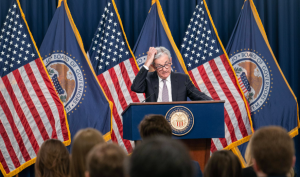How U.S. protectionism ignited a global trade quake – and where capital is fleeing now

💥 The Tariff Detonation: Policy Mechanics
President Trump’s April 2025 two-tier tariff system unleashed unprecedented trade warfare:
- Tier 1: 10% baseline tariff on all Chinese imports, effective April 9, 2025
- Tier 2: Additional 11-50% punitive tariffs targeting strategic sectors (semiconductors, EVs, solar panels), pushing effective rates on critical goods like solar silicon wafers to 60%
China retaliated within 48 hours with 34% blanket tariffs on U.S. goods, followed by Trump’s threat of a further 50% escalation – potentially creating a 104% total tariff barrier
. This exchange triggered the Nasdaq’s worst single-day crash (-10.02%) since 2022 and amplified recession probabilities to 60% per JPMorgan analysis
🚢 Supply Chain Fault Lines in Real-Time
Our Global Disruption Index (GDI) tracks four critical fracture zones:
1. Automotive Chain Collapse
- U.S. auto tariffs (25%) on Mexican imports forced Volkswagen and Mercedes-Benz to halt shipments from Mexico, causing U.S. new car prices to surge 10,000
- Secondary impact: Used car demand spiked 37% as consumers abandoned new vehicle purchases, while Tesla delayed Gigafactory expansions due to tariff-inflated steel costs
- GDI signal: North American auto part inventories (red) plunged to 12-day supply vs. 32-day pre-tariff norm.
2. Semiconductor Tech Blockade
- Dutch export controls expanded to block advanced EUV lithography machines to China, but backfired as Chinese firms like AMEC captured 30% domestic market share with breakthrough plasma etchers
- Shift detected: Taiwan’s TSMC accelerated Arizona fab openings, while South Korean suppliers rerouted chip packaging through Malaysia to avoid U.S. tariffs
3. Consumer Inflation Spiral
- Furniture (+46%) and wine (+30-50%) prices skyrocketed, adding $3,800/year to average household budgets
- Retail domino effect: IKEA shifted 40% China sourcing to Vietnam, while Walmart’s Q2 margins contracted 2.1% due to failed cost passthrough
4. Energy Sector Flashpoints
- Solar chaos: China’s LONGi Green Energy diverted 60% module production to Brazil, while U.S. installers faced 15-week delays and 22% cost hikes
⚔️ Policy Boomerang Effects
Trump’s tariffs are ricocheting back on the U.S. economy:
- GDP sabotage: The 60% tariff could reduce long-run U.S. GDP by 0.5%, while the 10% universal tariff adds 1.1% damage – a combined 1.6% GDP contraction
- Trade deficit myth: Tariffs strengthened the dollar by 7% since April, worsening the trade gap as U.S. exports became more expensive
- Manufacturing paradox: U.S. Steel delayed new plants due to imported iron ore tariffs, while “American-made” Tesla faced cost overruns
🛡️ Corporate Survival Playbook
Adaptive Strategies in Action:
→ Tariff Arbitrage
- ASEAN pivot: Chinese solar firms relocated wafer production to Malaysia, using RCEP rules to cut U.S.-bound tariffs from 60% to 15%
→ Tech Sovereignty Push
- SMIC’s 5nm breakthrough: Achieved with ASML-sanctioned DUV machines, evading EUV export bans
→ Consumer Downgrading
- Walmart’s “Basic” rebrand: Launched tariff-proof private labels replacing Chinese goods with Indian textiles and Mexican appliances
.
🔮 Recession Watch: Critical Thresholds
Monitor these real-time Disruption Index signals:
- 🚨 RED ZONE: U.S. consumer confidence < 61.3 (12-year low)
+ diesel demand ↓8.2% (industrial slowdown)
- 🟢 RECOVERY ZONE: ASEAN export growth >22% YoY + Mexico nearshoring FDI >$10B/quarter
💎 Veritas Capital’s Conclusion
“Tariffs are economic quicksand – the harder governments fight, the deeper they sink. Winners won’t be tariff-compliant firms, but those who rewired supply chains before the tremors hit.”
— Kenji Yamamoto, Head of Global Logistics, Veritas Capital
Final Alert: Our GDI shows Europe as next domino – ECB may cut rates to 1.75% if German industrial output dips below -0.1%
